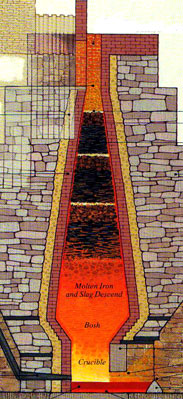
What Goes on in the Blast Furnace?
The blast furnace has been "blown in" and is ready for use. For maximum efficiency it will be run continuously for two twelve-hour shifts, 24 hours a day as long as possible. Any time the furnace is down, heat will be lost. Time and charcoal will then have to be wasted getting it back into production.
 The founder orders the fillers (or filler and a helper) to "charge" the furnace by emptying about twenty baskets of clean charcoal in the tunnel head, followed by 700 or so pounds of iron ore, then enough limestone for flux. The founder's experience and skill in determining the amounts of each ingredient will largely determine the quality of the output. When, in about half an hour, the initial charge has sunk ten feet or so into the furnace, another charge in the same order: iron ore, charcoal, limestone, then more iron ore, will be added throughout the shift. "Little and often is best" was the rule. The charges are heated and dried by hot gases rising from below as they fall into the fiery bed of glowing coals at the bosh-- about the midpoint of the furnace. Meanwhile a blast of cold air is being forced into the bosh from below, furnishing oxygen to intensify the heat and helping hold the materials from falling to the bottom of the furnace.
The founder orders the fillers (or filler and a helper) to "charge" the furnace by emptying about twenty baskets of clean charcoal in the tunnel head, followed by 700 or so pounds of iron ore, then enough limestone for flux. The founder's experience and skill in determining the amounts of each ingredient will largely determine the quality of the output. When, in about half an hour, the initial charge has sunk ten feet or so into the furnace, another charge in the same order: iron ore, charcoal, limestone, then more iron ore, will be added throughout the shift. "Little and often is best" was the rule. The charges are heated and dried by hot gases rising from below as they fall into the fiery bed of glowing coals at the bosh-- about the midpoint of the furnace. Meanwhile a blast of cold air is being forced into the bosh from below, furnishing oxygen to intensify the heat and helping hold the materials from falling to the bottom of the furnace.
The bosh is the heart of the furnace. There, as the heat reaches between
2600 and 3000 degrees Fahrenheit, a chemical reaction begins. At those
temperatures, the iron ore, almost always an iron oxide (such as magnetite-- Fe3O4,
or hematite Fe2O3), transforms into iron and carbon dioxide or
carbon monoxide. As the iron melts, becoming a heavy molten fluid, it
sinks to the crucible or bottom of the furnace. Meanwhile the limestone
becomes a fluxing material, uniting with other impurities in the ore
to form a molten waste fluid that also sinks into the crucible. Being
lighter in weight it floats atop the molten iron.
After eight or nine hours the furnace's products have filled the crucible. At the founder's order a bell is rung, announcing that the furnace is ready to pour and that all hands not otherwise needed will come to the Casting Room below to help harvest a half-day's work. The founder will go below to examine the slag. Its texture (from rough clinkers to smooth glassy stones) and color will tell him much about the ore he is working with. Dark gray slag indicates a high grade of ore; green or black indicates a protoxide ore; brown comes from magnetic ore, dirty yellow or red from peroxide ores, and turquoise blue when there is manganese in the ore. With this information he returns to the Charging House prepared once more to charge the furnace.
Return to:
One-Minute Essays
 |
|

|